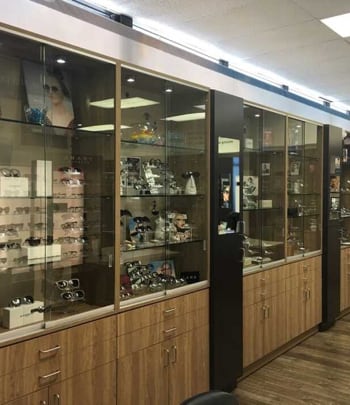We’re Here to Help Preserve Your Eye Health
Everybody’s eye health is different, so it’s vital to keep up with your regular eye care routine by visiting Dr. Goldstone Vision Center in Fountain Valley for eye exams.
We can help detect, diagnose, and manage various eye diseases and conditions with the help of modern solutions, our knowledgeable and passionate doctors, and the powerful network provided by Total Vision.
Discover what it means to have a clear view of your eye health and book your next appointment with us today. We proudly serve patients in both Fountain Valley and Long Beach.
The Importance of an Eye Exam
Our comprehensive eye exam process helps us determine several things about your eyes, including their health and vision quality. We use various technologies to get a deep look at the structures that make up your eye and determine their risk of developing a disease or condition.
We’ll examine your retina, macula, optic nerve, crystalline lens, and intraocular pressure to detect early warning signs of disease. We’ll also consider other aspects that may increase the risk of developing potential problems, like your family health history and personal health condition.
Early detection of eye diseases and conditions is the first step towards preserving your sight.


Common Eye Diseases & Conditions
One of the most important reasons to have an eye exam is that many eye diseases and conditions can develop without noticeable symptoms. In many cases, you may only experience symptoms after they permanently damage your vision.
Aging typically raises your risk of developing several eye health and vision problems, but other issues like diabetes or smoking cigarettes can also increase your risk.
Glaucoma
Glaucoma is a group of eye diseases that affect your optic nerve. In many cases, we can detect glaucoma by measuring your intraocular pressure (IOP), but some types of glaucoma can develop within normal IOP ranges.
Some of the most common types of glaucoma include:
Open-Angle Glaucoma
Open-angle glaucoma develops when tiny blockages form in your eye’s natural drainage system. Over time, your IOP levels can rise and damage your optic nerve.
Open-angle glaucoma is often referred to as the “silent thief of sight,” but we can detect it by measuring your IOP levels or observing your optic nerve during a comprehensive eye exam.
Angle-Closure Glaucoma
Angle-closure glaucoma is an emergency type of glaucoma that can rapidly raise your IOP to critical levels, causing nausea, eye pain, blurry vision, or sudden vision loss.
You may develop angle-closure glaucoma when your eye’s drainage system closes completely. If you experience these symptoms, call us immediately for an emergency eye exam.
Normal-Tension Glaucoma
Normal-tension glaucoma is a version of the disease that occurs while your IOP levels are within a normal range.
While there is no known cause of normal-tension glaucoma, our doctors can detect it by examining your optic nerve during an eye exam.
Age-Related Macular Degeneration
Age-related macular degeneration (AMD) is one of the most common age-related eye diseases. In fact, AMD is considered a leading cause of blindness in adults over 55.
AMD affects a part of your eye known as the macula. The macula is responsible for providing you with the central vision you use to see fine details. Over time, AMD can blur or distort your central vision and possibly lead to vision loss in advanced cases.
There are 2 different types of AMD:
Dry AMD
Dry AMD occurs as your macula thins while you age. Some research suggests that a lipid known as drusen develops under your eye as you age, slowly deteriorating it and affecting your vision.
Wet AMD
Wet AMD is an emergency form of the disease responsible for 90% of all AMD-related vision loss.
Wet AMD can develop when abnormal blood vessels under your macula begin to leak fluids, causing the macula to swell. Sudden symptoms can occur like visual distortions, blurriness, reduced color vibrancy, and poor vision in low light.
If you notice these symptoms, please contact us for an emergency eye exam.
Diabetic Eye Diseases
Diabetes can increase the risk of several eye diseases, the most common being diabetic retinopathy and diabetic macular edema.
If you have diabetes, we recommend having regular eye exams to help manage your eye health and detect potential problems before they permanently affect your vision. You can find out more about diabetic eye diseases by visiting our Diabetic Eye Exams page.
Cataracts
Cataracts are a common age-related eye condition that could affect your vision quality.
Your crystalline lens, located right behind your iris, is responsible for focusing light on your retina by changing its shape depending on how far you may be looking. However, over time, proteins in your eye’s lens can break down and make the lens more rigid—eventually, it can develop a milky, hazy color that could obstruct your vision.
Cataracts could lead to blindness, but cataract surgery can help by removing your cataract lens and replacing it with an artificial intraocular lens. In other cases, glasses and contact lenses could help correct early cataract-related vision problems.
Manage Your Eye Health Today
It’s time to take control of your eye health with the help of the team at Dr. Goldstone Vision Center.
Book your appointment today!
Visit Us Today

Visit us
Only 10 minutes down the road from Huntington Beach, you can find our practice in Magnolia Plaza, near Savers.
- 9107 Garfield Ave
- Fountain Valley, CA 92708
Hours of Operation
- Monday: 9:00 AM – 6:00 PM
- Tuesday: 9:00 AM – 6:00 PM
- Wednesday: 9:00 AM – 6:00 PM
- Thursday: 9:00 AM – 6:00 PM
- Friday: 9:00 AM – 6:00 PM
- Saturday: Closed
- Sunday: Closed


Our Brands












